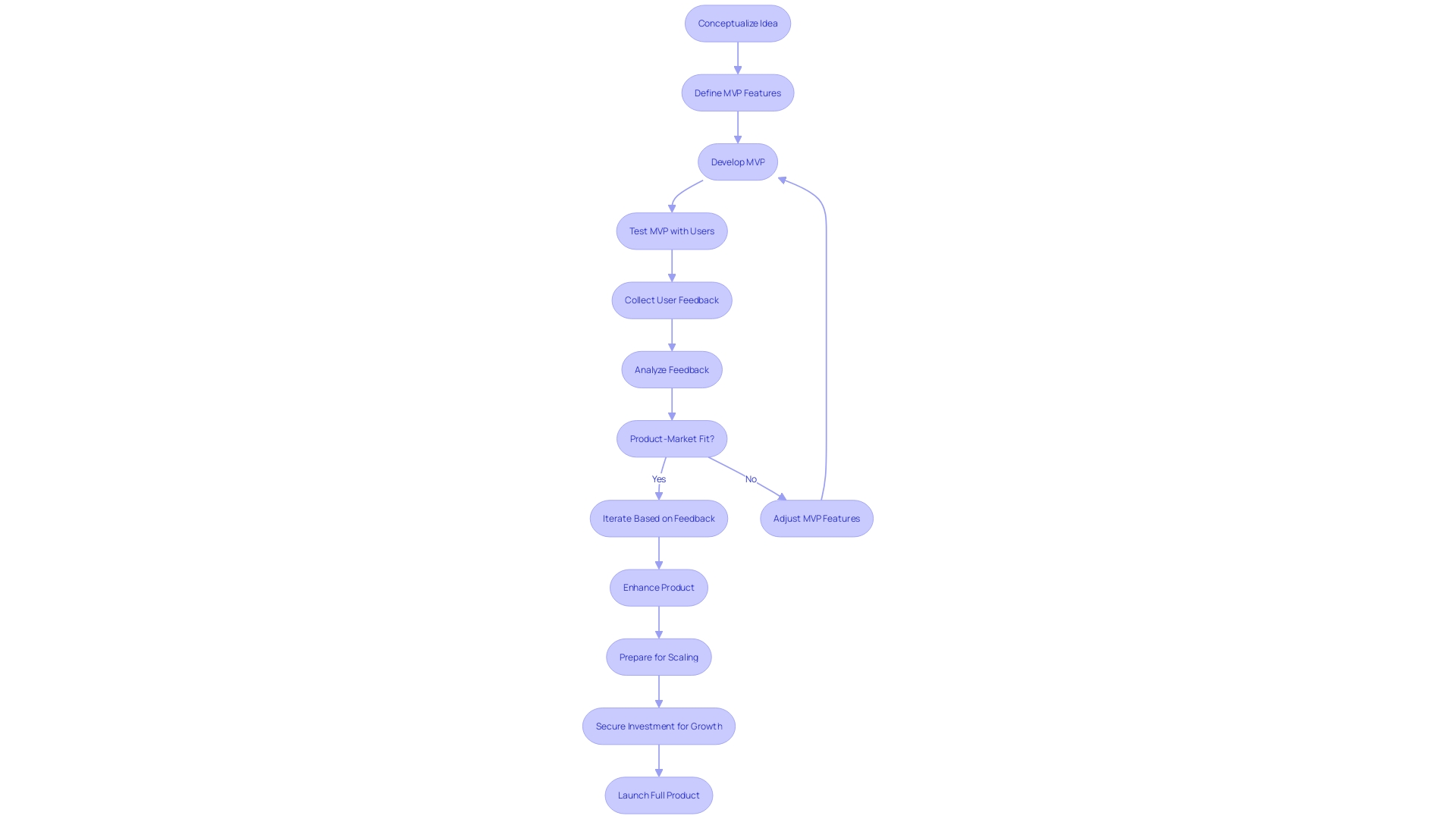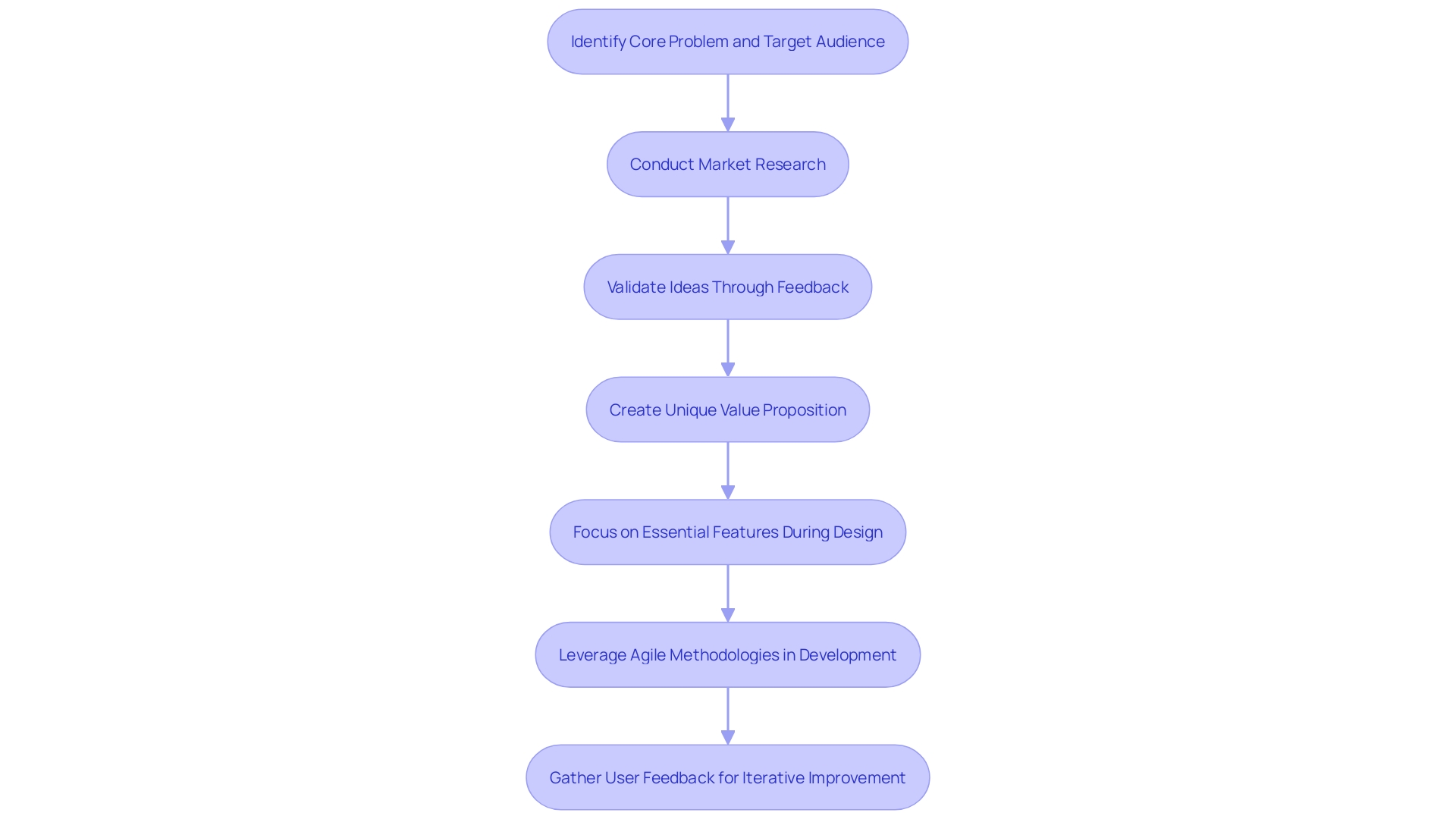Introduction
The concept of Minimum Viable Product (MVP) Software Development has revolutionized how businesses introduce their products to the market. By incorporating just enough features to attract early users and validate a product idea, MVPs allow companies to test product-market fit and adjust before committing substantial resources. This strategic approach has proven vital in distinguishing between a solution to an actual problem and a mere commodity.
MVPs also serve as a litmus test for startups, allowing them to demonstrate their product's viability and secure support for future development. In this article, we will explore the benefits of MVP development, provide a step-by-step guide, discuss common pitfalls to avoid, and showcase successful case studies of MVP implementations in enterprises. Join us as we delve into the world of MVP Software Development and discover how it can unlock the potential for success in the competitive marketplace.
Understanding the Concept of MVP
The practice of MVP Software Development is a strategic approach that empowers businesses to introduce their product concepts into the market with minimal initial outlay. The essence of an MVP is to incorporate just enough features to attract early users and validate a product idea early in the development cycle. This concept has been exemplified by projects like "The Barcode", a mobile app that revolutionized how bars and clubs engage with their clientele.
The development team worked closely with entrepreneurs to not only launch an MVP but also to iteratively enhance the app based on user feedback.
Harvard Business Review reports that a significant number of startups fail to generate a positive return for investors. Often, this is due to a lack of market need or the inability to secure adequate funding—challenges that can be addressed through a well-constructed MVP. By focusing on core functionalities, an MVP allows for testing product-market fit and adjusting before substantial resources are committed.
This approach is crucial in establishing whether a product solves a pressing problem for its intended users.
The MVP process also serves as a litmus test for distinguishing whether a product is a solution to an actual problem or merely a commodity. It's imperative to discern this distinction; what may seem like a critical issue in one context might be trivial in another. The development and validation of an MVP can prevent the all-too-common pitfall of building a product based on misconceived needs.
Statistics underline the importance of MVPs in modern business strategies. A robust MVP can pave the way for startups to demonstrate their product's viability to investors and early adopters with the least amount of effort, thereby securing the necessary support for future development. In an ever-evolving marketplace, the ability to rapidly adapt and optimize a product based on real-world feedback is invaluable, and MVP Software Development stands as a cornerstone in achieving this agility.

Benefits of MVP Development for Enterprises
MVP development stands as a pivotal strategy for companies aiming to launch innovative products or services effectively. Here are the key benefits of embracing an MVP approach:
-
Market Validation: An MVP allows businesses to test their product's market demand and collect genuine feedback from users. This crucial step provides valuable insights, guiding strategic decisions for future enhancements and confirming the product's relevance in the market.
-
Cost and Time Efficiency: By prioritizing core functionalities, companies can deploy their MVPs rapidly and with fewer resources. This approach mitigates the risk of investing heavily in features that may not align with market needs, therefore saving on both development costs and time.
-
Early User Engagement: Releasing an MVP enables engagement with early adopters, fostering a community of users who can offer direct feedback. This early interaction is instrumental in refining the product and aligning it closely with user expectations, often leading to a more dedicated user base.
-
Competitive Advantage: Introducing an MVP to the market can provide a significant head start over competitors. It allows companies to establish a market presence, attract potential investors, and forge strategic partnerships, all based on the promise and potential of the product's initial iteration.
Statistics reveal that a substantial number of startups do not manage to provide a positive return to their investors, with a lack of market need often cited as a primary reason for failure. Therefore, the role of an MVP in validating a product and demonstrating its potential to solve real-world problems cannot be overstated. Moreover, MVP development is not just about being a solution but also about identifying whether the product serves as a commodity that simplifies life, a distinction that's essential for successful product positioning.
Step-by-Step Guide to MVP Development
Crafting a Minimum Viable Product (MVP) is an essential step for businesses aiming to introduce a new software solution to the market. This approach is not just about creating a product; it's about fostering an iterative process that starts with identifying the core problem and the intended audience who will benefit from the solution. By pinpointing a specific issue, your MVP will serve a targeted need, enhancing its potential for success.
Market research is the cornerstone of this process. It provides the intelligence needed to recognize market demand, competition, and untapped opportunities. Moreover, it's through feedback from potential users and insights from industry experts that ideas are validated, ensuring the MVP is on the right track.
A compelling Unique Value Proposition (UVP) is what distinguishes your MVP from existing alternatives. It articulates the unique benefit your product offers, which is crucial in capturing the interest of your target audience.
The design phase should concentrate on the MVP's essential features, with a user experience that's both simple and intuitive. This focus on core functionalities ensures that the MVP remains manageable, while also providing early adopters with a clear understanding of the product's key benefits.
The development stage leverages agile methodologies to create a product that is not only functional but also stable and scalable. Prioritizing the most crucial features and functionalities during this phase sets the foundation for a product that can grow and evolve based on market feedback.
Once the MVP is launched, the real work begins. Gathering and analyzing user feedback is pivotal for iterative improvement. This ongoing cycle of testing, learning, and enhancing ensures that the product continues to evolve in response to real user needs and preferences, maximizing its chances of success in the competitive marketplace.
One illustrative example of MVP development in action is 'The Barcode,' an innovative mobile app for the hospitality industry. It demonstrates how a clear vision, combined with user feedback and continuous enhancement, can lead to a successful product that resonates with its target audience. This case study highlights the significance of an MVP in transforming a concept into a reality, emphasizing the importance of starting with a solid foundation that meets a market need while also being adaptable based on user feedback.
In summary, the journey of MVP development is a strategic and measured path that involves defining problems, validating ideas through research, carving out a unique space in the market with a compelling value proposition, and engaging in a design and development process that's both agile and user-centric. This approach reduces early risks and positions your product for a better market fit, ultimately increasing the likelihood of a positive return on investment.

Common Pitfalls in MVP Development and How to Avoid Them
Navigating the intricacies of MVP software development can be fraught with pitfalls that threaten the success of your enterprise. To maximize the potential of your Minimum Viable Product, sidestep these common traps:
-
Simplify to Amplify: Resist the urge to embellish your MVP with superfluous features. The essence of MVP is to deliver a streamlined, core value proposition to your users. Remember, complexity is the enemy of clarity.
-
The User's Voice: User feedback is the compass that guides the MVP journey. Embracing user input is essential; it illuminates the path to refinement and ensures your product evolves in alignment with customer needs.
-
Market Wisdom: Without a solid grasp of market needs, customer behavior, and competitive landscapes, your MVP may veer off course. In-depth market research is the radar for navigating these waters, steering you clear of unseen dangers and towards informed strategic choices.
-
Execution Excellence: The quality of your MVP's execution can set the tone for your product's reputation. Quality assurance and meticulous development practices are indispensable, ensuring that your MVP not only functions but impresses and engages users from the outset.
For instance, 'The Barcode,' a mobile app designed to revolutionize patron engagement for bars and clubs, is a testament to the importance of MVP. The development team focused on iterative enhancements, actively incorporating user feedback to refine the app and deliver on its promise. Similarly, Appinventiv's work with industry giants like KFC demonstrates how adopting the Lean Startup Methodology—the practice of validating product ideas and iterating based on user insights—can propel a business forward.
In the realm of software development, MVP is not just a product; it's a strategic approach that validates your idea against real-world user feedback, optimizing resource allocation and setting the stage for future scalability. The cautionary tales of startups that failed due to a lack of market need or insufficient capital underscore the importance of MVP in mitigating early-stage risks and aligning product development with genuine market demand.

Best Practices for Successful MVP Development
The essence of MVP software development lies in its simplicity and focus. Begin by identifying whether your product is a solution to a specific problem or a commodity that enhances users' lives. This understanding is vital as it shapes the features you choose to include.
Keep your product stripped down to the essentials—features that present the most value to your users. This approach avoids feature creep and streamlines your offering.
Iterative development is crucial; with each release, concentrate on delivering an improved outcome for the users. Utilize user feedback to inform continuous improvement, ensuring that your MVP evolves in alignment with user needs. Data plays a central role in decision-making; gather analytics and feedback diligently to guide the evolution of your product.
Communication within your development team cannot be overstated. A collaborative environment with clear communication channels can significantly impact the success of your MVP. Remember, products are vehicles for delivering value, and your MVP should be a focused effort to deliver a singular, valuable outcome to your customers.
Above all, maintain a user-centric approach throughout the development process. Understanding your users' needs, pain points, and preferences is paramount. As you consider these best practices, remember the words of a seasoned product developer, 'Building a minimum viable product is more about the testing, learning, and iteration process itself.'
It's a journey of discovery, adjustment, and refinement as you steer your MVP towards market success.
Case Studies: Successful MVP Implementations in Enterprises
Examining case studies of MVP development offers a lens into how lean product strategies can catalyze business growth. For instance, Airbnb's journey began with the founders offering their own apartment to guests, validating the demand for a peer-to-peer lodging service. Their continuous iteration based on user feedback propelled Airbnb to become a global leader in accommodations.
Dropbox, too, started with a rudimentary but functional prototype that showcased the essentials of cloud storage and file sharing. This strategic move allowed them to confirm market demand and subsequently scale to a large user base, establishing Dropbox as a top provider in cloud storage services.
Similarly, Buffer's initial MVP centered on a single functionality—scheduling social media posts. Through persistent enhancement based on user insights, Buffer evolved into a widely used social media management platform. These narratives underscore the efficacy of beginning with a minimal yet viable product, engaging with users closely, and refining the product in alignment with user needs and feedback.
Meanwhile, Pinterest's remarkable ascent to 11 million monthly active users with just a handful of engineers underscores the power of starting simple. Their MVP was built on familiar technologies and a straightforward MySQL database, illustrating the significance of simplicity and proven technologies in MVP development.
These examples highlight not only the strategic importance of MVPs but also the critical role of user-centric design and feedback in refining and perfecting a product. It's about identifying a core problem, offering a solution, and then meticulously iterating to align the product more closely with user expectations and market demands.
Conclusion
In conclusion, MVP Software Development revolutionizes how businesses introduce products to the market. By incorporating enough features to attract early users and validate ideas, MVPs allow companies to test product-market fit and adjust before committing substantial resources. This strategic approach distinguishes between a problem-solving solution and a mere commodity.
MVPs serve as a litmus test for startups, demonstrating product viability and securing support for future development. Benefits include market validation, cost and time efficiency, early user engagement, and a competitive advantage.
To achieve successful MVP development, avoid common pitfalls like unnecessary features, neglecting user feedback and market research, and compromising on execution excellence. Best practices involve identifying the core problem and target audience, focusing on essential features, adopting iterative development, and maintaining a user-centric approach.
Examining case studies like Airbnb, Dropbox, Buffer, and Pinterest highlights the importance of starting with a minimal yet viable product, engaging closely with users, and refining based on their needs.
Overall, MVP Software Development offers a strategic path for effective product introductions. By testing product-market fit early and adjusting before committing resources, companies position themselves for success. Navigating pitfalls and following best practices maximize the potential of MVP development, aligning with market demand.
Experience the power of MVP Software Development for your business today!





